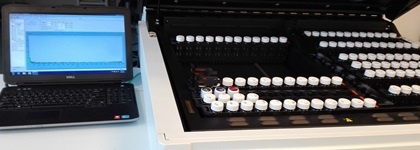Primary production
Pelagic primary production is defined as the flux of inorganic carbon into planktonic algae per unit time. Primary production is a fundamental ecological variable, because it is a measure of the primary energy input to the aquatic environment and because of its significance to indicate and characterise the condition of a particular water body. Primary production can be measured conveniently using the so-called 14C method (Steemann-Nielsen 1952). By adding a known amount of the radioactive isotope 14C to a water sample, the algae will take up 14C along with "native" 12C present in water. After a short incubation period (hours) the 14C incorporated into the algae cells can be measured by liquid scintillation counting, and the total carbon uptake can be calculated using:
12CO2 uptake = (14CO2 uptake/14CO2 added) * 12CO2 concentration
The method is very sensitive and the primary production is widely used in assessing water quality in relation to e.g., eutrophication in water environments. Primary production is also used as a vital parameter, for example when modelling how the changes in nutrient loads affect the environment.

Method
Primary production can be determined either as particulate production or total production. For particulate production, only the 14C uptake in the algae cells is determined, while total production also includes the 14C incorporated into organic matter, which is lost to the environment outside the cells during incubation.
The primary production can be measured in the field by incubating water samples spiked with 14C at different depths. However, this is rarely feasible offshore, and light incubators are often used to mimic the light climate in the water column.
It is important to start the incubation as soon as possible once the water samples have been collected. Experiments have shown that the storing of samples may cause a reduction in the rate of photosynthesis of up to 70-80 %, especially if the samples are stored in high light intensity. Storage in the dark causes a modest underestimation of the photosynthetic rate of up to 10 % provided the storage of the samples does not exceed 6 hours.

Daily primary production in phytoplankton sampled at 8:00, stored under different light conditions and sub-sampled every 2-4 hours.
Particulate production:
- sub-samples are spiked with a known amount of 14C and the samples are subsequently incubated for a specific period of time
- the samples are filtered onto a filter with a pore size less than the size of the algae cells
- the filters are washed with 0.2 µm filtrated water sample
- the filters are placed in a glass vial and acidified in a fume hood in order to remove inorganic 14C
- after 24 hours scintillation cocktail is added to the filters
- after additional 24 hours the samples are ready to be counted by a scintillation counter
Total production:
- sub-samples are spiked with a known amount of 14C and the samples are subsequently incubated for a specific period of time
- the incubation is stopped
- an aliquot, e.g., 5-10 ml, is placed in a glass vial and acidified in a fume hood in order to remove inorganic 14C
- after 24 hours scintillation cocktail is added to the aliquot
- after additional 24 hours the samples are ready to be counted by a scintillation counter